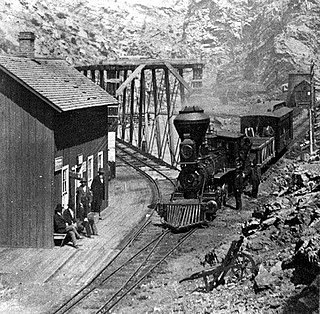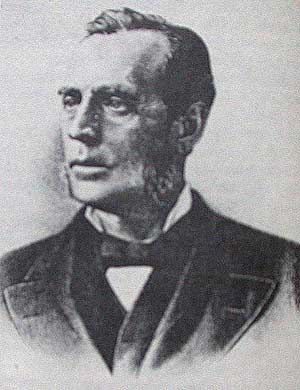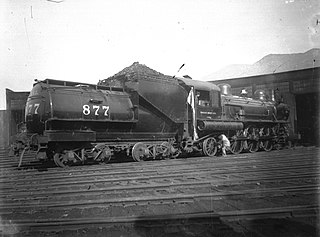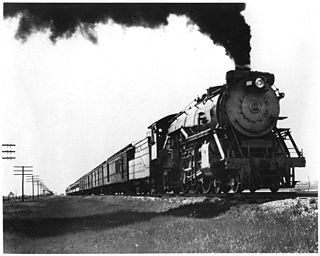
The Denver and Rio Grande Western Railroad, often shortened to Rio Grande, D&RG or D&RGW, formerly the Denver & Rio Grande Railroad, was an American Class I railroad company. The railroad started as a 3 ft narrow-gauge line running south from Denver, Colorado, in 1870. It served mainly as a transcontinental bridge line between Denver and Salt Lake City, Utah. The Rio Grande was also a major origin of coal and mineral traffic.

The Missouri Pacific Railroad, commonly abbreviated as MoPac, was one of the first railroads in the United States west of the Mississippi River. MoPac was a Class I railroad growing from dozens of predecessors and mergers. In 1967, the railroad operated 9,041 miles of road and 13,318 miles of track, not including DK&S, NO&LC, T&P, and its subsidiaries C&EI and Missouri-Illinois.

The Colorado Central Railroad was a U.S. railroad company that operated in Colorado and southeastern Wyoming in the late 19th century. It was founded in the Colorado Territory in the wake of the Colorado Gold Rush to ship gold from the mountains. It expanded from its Golden–Denver line to form a crucial link connecting Colorado with the transcontinental railroad and the national rail network. The history of the railroad throughout the 1870s was driven at times by a fierce struggle between local interests, led by W.A.H. Loveland, and outside investors of the Union Pacific Railroad led at times by Jay Gould. The early struggle of the company to build its lines was a major part of the early competition between Denver and Golden for supremacy as the principal metropolis of Colorado.
The Denver Pacific Railway was a historic railroad that operated in the western United States during the late 19th century. Formed in 1867 in the Colorado Territory, the company operated lines in Colorado and present-day southeastern Wyoming in the 1870s until merging with the Kansas Pacific and Union Pacific railroads in 1880. The railroad was formed primarily to create a link between Denver and the transcontinental railroad at Cheyenne, an achievement that was widely credited at the time with making Denver the dominant metropolis of the region.

William Austin Hamilton Loveland was a U.S. railroad entrepreneur and businessman in the late 19th century. An early resident of Golden when it was the capital of the Colorado Territory, he was one of the founders of the Colorado Central Railroad and a principal figure in the early history of Colorado. As president of the Colorado Central, he was instrumental in the expansion of the railroad network into the mining communities of Colorado. For much of the 1870s Loveland waged a fierce struggle with Union Pacific investors for control of the Colorado Central. He also served as Lieutenant Governor of Colorado.
The Kansas Pacific Railway (KP) was a historic railroad company that operated in the western United States in the late 19th century. It was a federally chartered railroad, backed with government land grants. At a time when the first transcontinental railroad was being constructed by the Central Pacific and the Union Pacific, it tried and failed to join the transcontinental ranks. It was originally the "Union Pacific, Eastern Division", although it was completely independent. The Pennsylvania Railroad, working with Missouri financiers, designed it as a feeder line to the transcontinental system. The owners lobbied heavily in Washington for money to build a railroad from Kansas City to Colorado, and then to California. It failed to get funding to go west of Colorado. It operated many of the first long-distance lines in the state of Kansas in the 1870s, extending the national railway network westward across that state and into Colorado. Its main line furnished a principal transportation route that opened up settlement of the central Great Plains, and its link from Kansas City to Denver provided the last link in the coast-to-coast railway network in 1870. The railroad was consolidated with the Union Pacific in 1880, and its mainline continues to be an integral part of the Union Pacific network today.

David Halliday Moffat was an American financier and industrialist.
The Denver and New Orleans Railroad (D&NO) was a railroad in Colorado started by Colorado Governor John Evans, along with railroad entrepreneur David Moffat and other associates in 1881. Originally chartered to build a railroad from Denver, Colorado to the Gulf of Mexico, the charter was later changed instead connect southward to the Fort Worth and Denver City Railway which was building northwest from Fort Worth, Texas.

The Oregon Short Line Railroad was a railroad in Wyoming, Idaho, Utah, Montana and Oregon in the United States. The line was organized as the Oregon Short Line Railway in 1881 as a subsidiary of the Union Pacific Railway. The Union Pacific intended the line to be the shortest route from Wyoming to Oregon and the Pacific Northwest. Construction was begun in 1881 at Granger, Wyoming, and completed in 1884 at Huntington, Oregon. In 1889 the line merged with the Utah & Northern Railway and a handful of smaller railroads to become the Oregon Short Line and Utah Northern Railway. Following the bankruptcy of Union Pacific in 1897, the line was taken into receivership and reorganized as the Oregon Short Line Railroad (“OSL”). The OSL became a part of the Union Pacific System in the Harriman reorganization of 1898.

The Fort Worth and Denver Railway, nicknamed "the Denver Road", was a class I American railroad company that operated in the northern part of Texas from 1881 to 1982, and had a profound influence on the early settlement and economic development of the region.

The Colorado and Southern Railway was an American Class I railroad in the western United States that operated independently from 1898 to 1908, then as part of the Chicago, Burlington and Quincy Railroad until it was absorbed into the Burlington Northern Railroad in 1981.

The Utah Division of the former Denver & Rio Grande Western Railroad (D&RGW) is a rail line that connects Grand Junction, Colorado and Salt Lake City, Utah in the Western United States. It is now incorporated into the Union Pacific Railroad (UP) system as part of the Central Corridor. The modern Union Pacific has split the line into two subdivisions for operational purposes, the Green River Subdivision between Grand Junction and Helper, Utah and the Provo Subdivision from Helper to Salt Lake City. Daily passenger service is provided by Amtrak's California Zephyr; the BNSF Railway and Utah Railway have trackage rights over the line.
Article X of the Texas Constitution of 1876 covers railroad companies and the creation of the Railroad Commission of Texas. The federal government later created the Interstate Commerce Commission to regulate railroads, and eight of the nine sections of Article X were repealed in 1969 as "deadwood".
The following is a brief history of the North American rail system, mainly through major changes to Class I railroads, the largest class by operating revenue.
The following is a brief history of the North American rail system, mainly through major changes to Class I railroads, the largest class by operating revenue.
The following is a brief history of the North American rail system, mainly through major changes to Class I railroads, the largest class by operating revenue.
The Cheyenne and Northern Railway was a railroad in the U.S. state of Wyoming. The railroad was incorporated in 1886 to build a line from Cheyenne, Wyoming into northern Wyoming and Montana. The line extended 125 miles (201 km) to Wendover on the North Platte River. It was absorbed by Union Pacific Railroad subsidiary Union Pacific, Denver and Gulf Railway and later became part of the Colorado and Southern Railway when the Union Pacific went into receivership.

The Georgetown, Breckenridge and Leadville Railway was a railroad in Colorado incorporated in 1880. A portion of the line, known as the Georgetown Loop, was a tourism destination during the railroad company's operating period, and was rebuilt in the late 20th century as a heritage railway.








